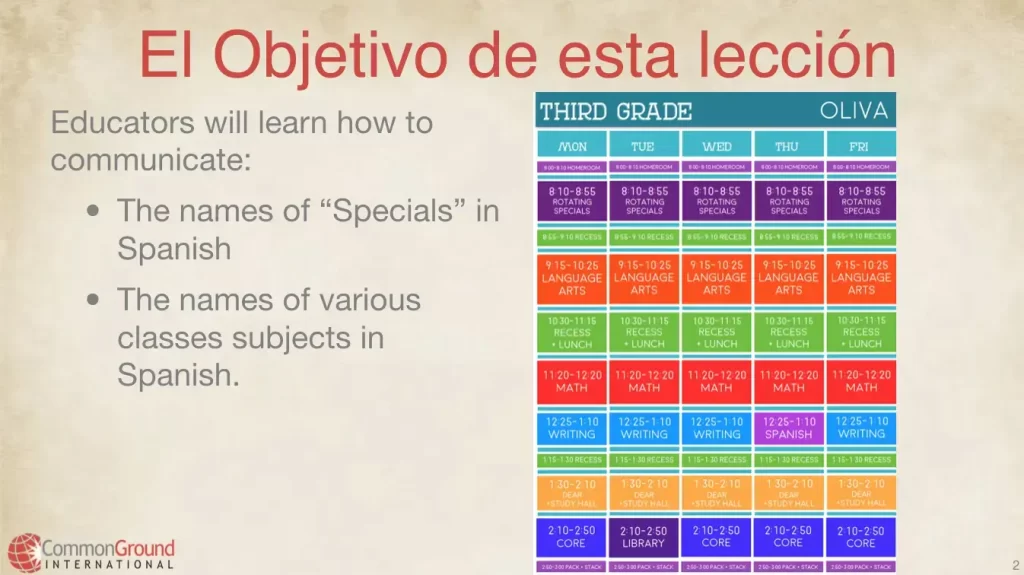In this Spanish for Educators lesson, you will learn how to form “lenguaje redirectivo” to implement positive redirection en español.
Teachers in our Spanish for Educators community speak up and we love it! Following your suggestions about the vocabulary you need to master in the classroom, we have developed this lesson about communicating class schedules in Spanish including the “Specials” and class subjects. This lesson will help you address this topic correctly with your Spanish speaking students.
Objetivos de la lección – Lesson Objectives
Educators will learn how to communicate:
- The names of various classes subjects in Spanish – Asignaturas
- The names of “Specials” in Spanish – Clases especiales
Here is the Specials and class subjects in Spanish lesson that I taught to the Facebook group:
Subscribe to our YouTube Channel to see all of our lessons and get the latest videos right away!
Las clases especiales – The “Specials”
The “Specials” are elective subjects taken in primary school, which are taught by specialized teachers to help students gain more specific knowledge about certain areas of interest.
Las clases especiales son clases electivas que se toman en primaria y las cuales son dictadas por profesores especializados para ayudar a los estudiantes a obtener conocimiento específico sobre ciertas áreas de interés.
A lot of these “Specials” are in fact cognados, so you can learn and use this vocabulary right away
| Spanish | English |
| El arte | Art |
| El idioma | Language |
| La biblioteca | Library |
| La música | Music |
| La tecnología | Technology |
| El almuerzo | Lunch |
| El recreo | Recess |
| La merienda | Snack |
| La religion | Religion |
| Los creadores | Maker Space |
| Los valores | Values |
Las Asignaturas – Primaria / Class Subjects – Primary
Now, let’s see an example of a schedule for a primary school student 🙂
For talking about the hours, from 8:00 AM to 11:59 AM you have to say: de la mañana
Example: 9:30 AM should be nueve y treinta (or nueve y media) de la mañana.
From 12:00 m to 12:59 m you should use: del mediodía.
Example: 12:30 m should be doce y treinta (or doce y media) del mediodía.
And, finally, from 1:00 PM to 6:59 PM you should say: de la tarde.
Example: 4:45 PM should be cuatro y cuarenta y cinco de la tarde.
| Hora | Spanish | English |
| 8:00 – 8:10 am | Saludos, calendario, y reunión de la mañana | Greetings / calendar / morning meeting |
| 8:15 – 9:00 am | Lectoescritura | Literacy |
| 9:05 – 10:00 am | Matemáticas | Math |
| 10:05 – 11:00 am | Especiales (arte, música, tecnología, educación) | Specials |
| 11:05 – 11:45 am | Recreo y almuerzo | Recess & Lunch |
| 11:50 – 12:40 pm | Estudios sociales / Ciencia | Social studies / Science |
| 12:45 – 1:30 pm | Especiales | Specials |
| 1:35 – 1:55 pm | Recreo | Recess |
| 2:00 – 2:30 pm | Inglés o español | English / Spanish |
| 2:35 – 2:50 pm | Trabajos | Class jobs |
| 2:55 – 3:05 pm | Reunión al final del día | End of day meeting |
Las asignaturas – Middle / High School
This is a good example of a schedule for a middle school student 🙂
| Hora | Spanish | English |
| 7:55 – 8:15 am | Salón de estudio | Study hall |
| 8:40 – 9:20 am | Música / guitarra / coro / banda | Music / guitar / choir / band |
| 9:25 – 10:05 am | Historia mundial | World history |
| 10:45 – 11:25 am | Álgebra | Algebra |
| 11:30 – 12:10 pm | Salud | Health |
| 12:15 – 1:40 pm | Ciencias físicas | Science |
| 1:45 – 2:25 pm | Español (1,2,3,4 AP) | Spanish |
| 2:30 – 3:10 pm | Inglés (1,2,3, etc) literatura | English / Literature / literacy |
Otras asignaturas – Other Subjects
Some other subjects your students could be taking this year.
| Spanish | English |
| Biología | Biology |
| Cáculo | Calculus |
| Química | Chemistry |
| Teatro | Theatre |
| Geografía | Geography |
Su reto profesional – Your Professional Challenge
¿Cuál es su horario? — Create your horario en español and explicarlo a sus estudiantes, padres y/o tutores.
- ¿Cómo van a aplicar este vocabulario en su aula?
- Pongan su rutina en español para sus estudiantes.
- Compartan su rutina con nosotros 🙂
- ¡Hasta la próxima vez!





